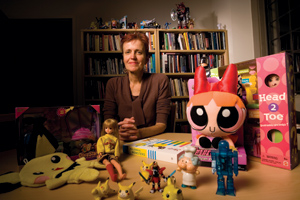|
||
      |
Peer Review ::
March of the Monsters
Anthropologist Anne Allison explores Pokémon’s play revolution.

Allison adorns her desk with J-Cool creatures.
When cultural anthropologist Anne Allison, AM’80, PhD’86, first told colleagues she was researching Pokémon, she got a lot of laughs. “‘Oh, that’s so cute,’ they would say,” recounts the Duke professor. Yet in her book Millennial Monsters: Japanese Toys and the Global Imagination (University of California Press, 2006), she argues such playthings are important cultural markers.
Japanese pop culture, also known as J-Cool—a category that includes colorful anime, big-eyed Hello Kitty creatures, and live-action Mighty Morphin Power Rangers—reflects the complicated, globalized world. From the “pocket monsters” of Pokémon (encompassing video games, cartoons, movies, trading cards, and other toys) to tamagotchi, egg-shaped virtual pets that must be fed and nurtured, J-Cool characters “change, shift, morph, die, and return to life.” Such flux, Allison says, mirrors the “incredible mobility, fluidity, and fragmentation” of the 21st century, where families disintegrate and individuals cross borders.
J-Cool’s international popularity—four years after a 1996 launch, Pokémon games were sold in 70 countries, the cartoon broadcast in 51—marks a shift from what Allison calls the “Disneyfication” of children’s entertainment. Unlike Disney’s theme parks and films like Beauty and the Beast, which lead viewers through highly crafted story lines, the Pokémon world is mutable and ambiguous. “We don’t know where this is, but it’s familiar,” said one ten-year-old whom Allison interviewed about the game’s universe, where players navigate a generic geography of towns, forests, and islands. As they interact with the environment, amassing tools and strategies to collect more than 300 pocket monsters, gamers create their own plotline.
Identity is also malleable in J-Cool. As a game advances, pocket monsters develop new powers. “Characters with bodies and powers that are endlessly remapped, recharged, and replaced,” says Allison, comprise a common motif of postwar Japanese “mass fantasies,” including the 1950s beast Gojira (Godzilla). The debut of Pokémon, first as a game for Nintendo’s Game Boy and later as trading cards and a cartoon, allowed kids to collect these “postgender, nonhuman” characters. Pokémon, says Allison, introduced a type of “media-mix” mass entertainment that required “interactivity rather than watching, consuming, or entering a story.” This virtual play atmosphere, she adds, goes hand-in-hand with the modern plugged-in lifestyle, and has since been adopted by Disney and other American companies.
Just as it blurs geography and identity, Japanese fantasy also obscures the line between childhood and adulthood. Unlike her amused colleagues, Allison explains, the Japanese “take fantasy seriously.” It’s not unusual, she says, to see a 35-year-old Tokyo businessman toting a Pikachu (Pokémon’s well-known yellow monster) cell-phone case. “Fantasy is not something you have to be embarrassed about,” says Allison, whose first book Nightwork: Sexuality, Pleasure, and Corporate Masculinity in a Tokyo Hostess Club (University of Chicago Press, 1994) analyzed high-priced nightspots where corporate executives bring (mainly male) employees or clients to be entertained by female hostesses. “The hostess pours the drinks, lights the cigarettes, and flatters the men,” says Allison, who worked as a hostess during her research. “It’s a form of fantasy that’s also serving business interests.”
J-Cool, likewise, is big business. As of August 2003, Pokémon games, toys, cards, and other merchandise had sold $15 billion worldwide. “The whole sphere of kids’ fantasies is expanding outward,” says Allison, who spent 1999–2000 in Japan interviewing toy producers, social commentators, child experts, parents, and children. Take All Nippon Airways’ fleet of Pokémon-themed jets. Decorated with Pikachu on the fuselage, these flights offer passengers an all-inclusive experience with pocket-monster headrests, food containers, goody bags, and movies. Allison sees the planes, marketed as much to adults as to children, as another case of lines being blurred. “Is a jet now a toy?” she asks. “Are toys now jets?”
Perhaps in Japan, but Americans may not be ready for a visibly protracted childhood. Unlike Japanese parents, who often play Pokémon with their kids and understand the game, most American parents Allison interviewed, she says, “were clueless.”